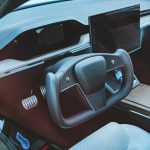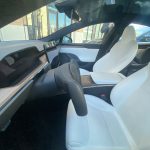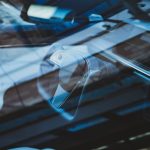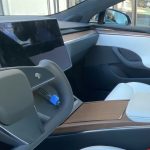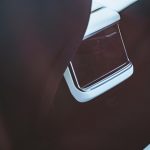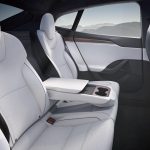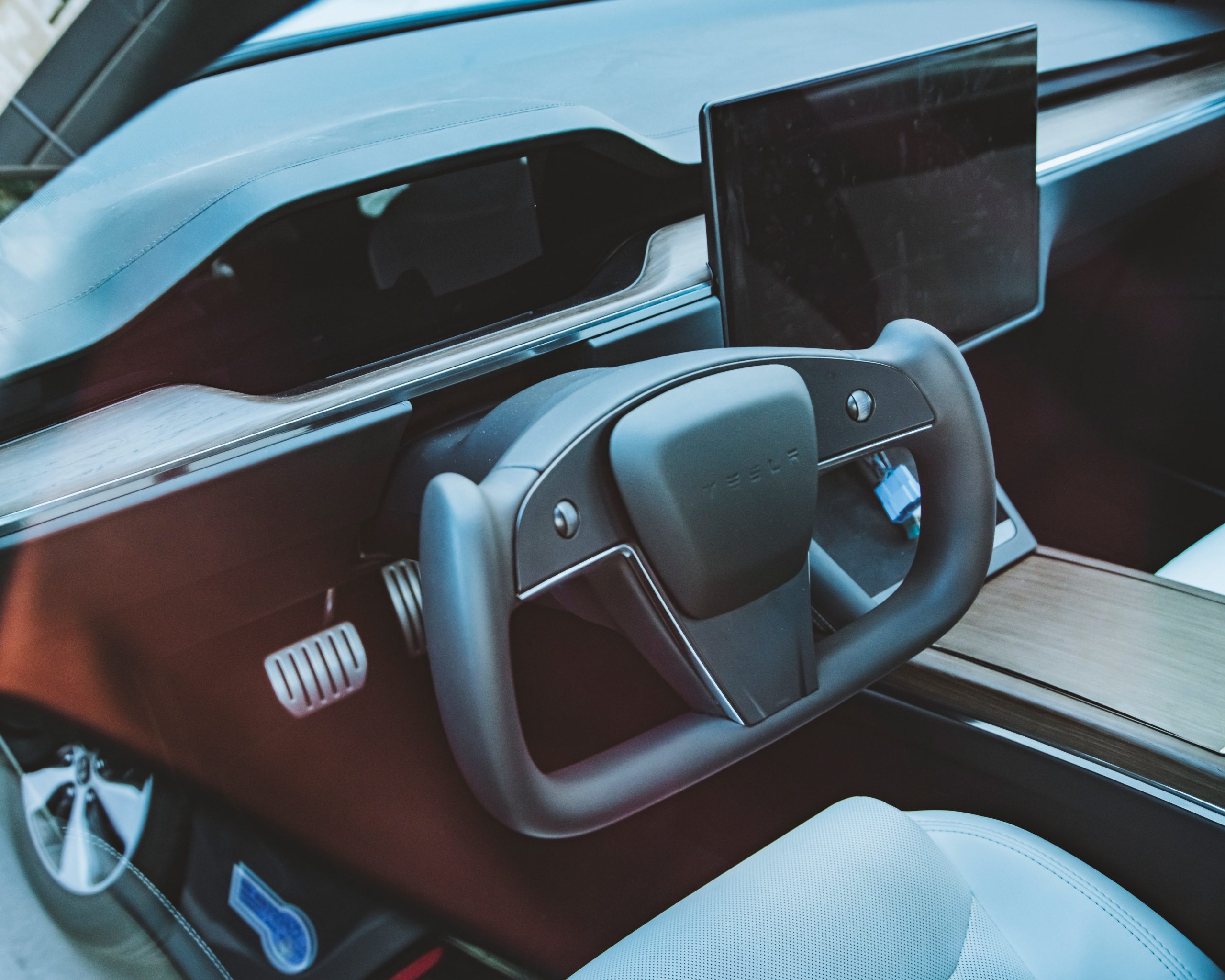
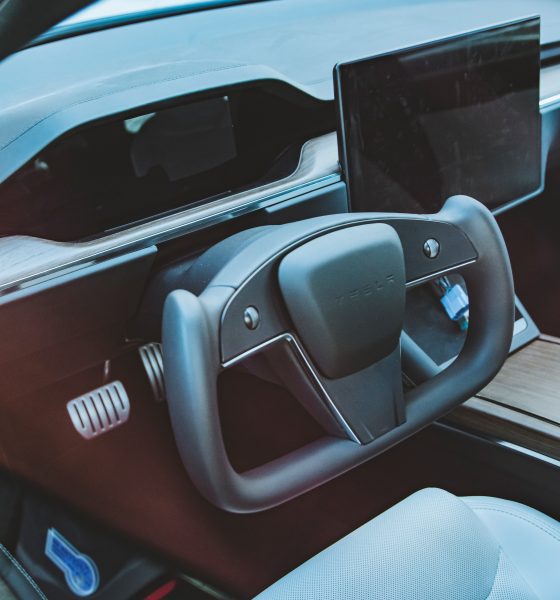
News
Tesla Model S with Yoke Steering wheel hits the public streets: First look
A Tesla Model S with a Yoke Steering wheel has been caught in the wild, giving the public a first look at Tesla’s futuristic stalkless steering column.
A Deep Blue Metallic Model S with a refreshed interior, including the wraparound wood door trim, revised instrument cluster display and horizontal center touchscreen, and Tesla’s highly-anticipated Yoke steering wheel, was spotted in downtown Redwood City in Silicon Valley on Saturday.
Photos captured by The Kilowatts reveal a Model S with manufacturer plates, indicating that the company may be in the final stages of public testing before rolling out the updated steering wheel design to production vehicles.
- Tesla Model S Yoke steering wheel and refreshed interior (Credit: The Kilowatts)
Photos by The Kilowatts
Notable in the photos of the Yoke steering wheel is the absence of a traditional stalk and Tesla’s familiar dual scroll wheels. While Tesla has showcased the capacitive touch functions in illustrations for the Model S and Model X refresh steering wheel, markings for turn signals and drive functions were not visible in the release candidate that was spotted.
What appears to be a production-ready driver and passenger section of the Model S, a refined rear passenger area, clad in Tesla’s famed Vegan white interior and highlighted by the company’s newest rearseat touchscreen display, was clearly evident.
- Tesla Model S interior rear seat touchscreen (Credit: The Kilowatts)
- Tesla Model S interior rear seat touchscreen armrest (Credit: Tesla)
The devil is in the details 😉 pic.twitter.com/CQheNrPy3o
— The Kilowatts 🚗⚡️ (@klwtts) February 27, 2021
In the photos shared by The Kilowatts, the button for folding-down the Model S split rear seats can also be seen, along with a more prominent side repeater camera.
Tesla revealed new images of the 2021 Refreshed Model S and Model X earlier this year following months of speculation that the company would be updating the aging interior design of its flagship vehicles.

News
Tesla owners could be impacted by new EV tax credit extension rule
We confirmed with a Tesla Sales Advisor that any current orders that have the $7,500 tax credit applied to them must be completed by December 31, meaning delivery must take place by that date. However, it is unclear at this point whether someone could still claim the credit when filing their tax returns for 2025 as long as the order reflects an order date before September 30.
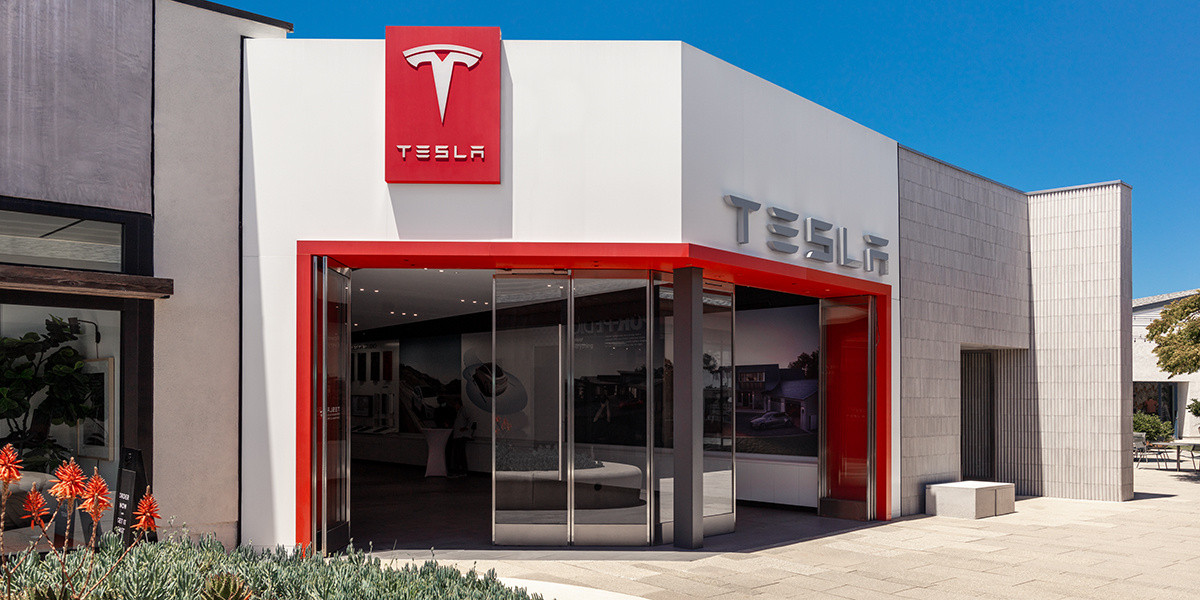
Tesla owners could be impacted by a new EV tax credit rule, which seems to be a new hoop to jump through for those who benefited from the “extension,” which allowed orderers to take delivery after the loss of the $7,500 discount.
After the Trump Administration initiated the phase-out of the $7,500 EV tax credit, many were happy to see the rules had been changed slightly, as deliveries could occur after the September 30 cutoff as long as orders were placed before the end of that month.
However, there appears to be a new threshold that EV buyers will have to go through, and it will impact their ability to get the credit, at least at the Point of Sale, for now.
Delivery must be completed by the end of the year, and buyers must take possession of the car by December 31, 2025, or they will lose the tax credit. The U.S. government will be closing the tax credit portal, which allows people to claim the credit at the Point of Sale.
🚨UPDATE: $7,500 Tax Credit Portal “Closes By End of Year”.
This is bad news for pending Tesla buyers (MYP) looking to lock in the $7,500 Tax Credit.
“it looks like the portal closes by end of the year so there be no way for us to guarantee the funds however, we will try our… pic.twitter.com/LnWiaXL30k
— DennisCW | wen my L (@DennisCW_) December 15, 2025
We confirmed with a Tesla Sales Advisor that any current orders that have the $7,500 tax credit applied to them must be completed by December 31, meaning delivery must take place by that date.
However, it is unclear at this point whether someone could still claim the credit when filing their tax returns for 2025 as long as the order reflects an order date before September 30.
If not, the order can still go through, but the buyer will not be able to claim the tax credit, meaning they will pay full price for the vehicle.
This puts some buyers in a strange limbo, especially if they placed an order for the Model Y Performance. Some deliveries have already taken place, and some are scheduled before the end of the month, but many others are not expecting deliveries until January.
Elon Musk
Elon Musk takes latest barb at Bill Gates over Tesla short position
Bill Gates placed a massive short bet against Tesla of ~1% of our total shares, which might have cost him over $10B by now
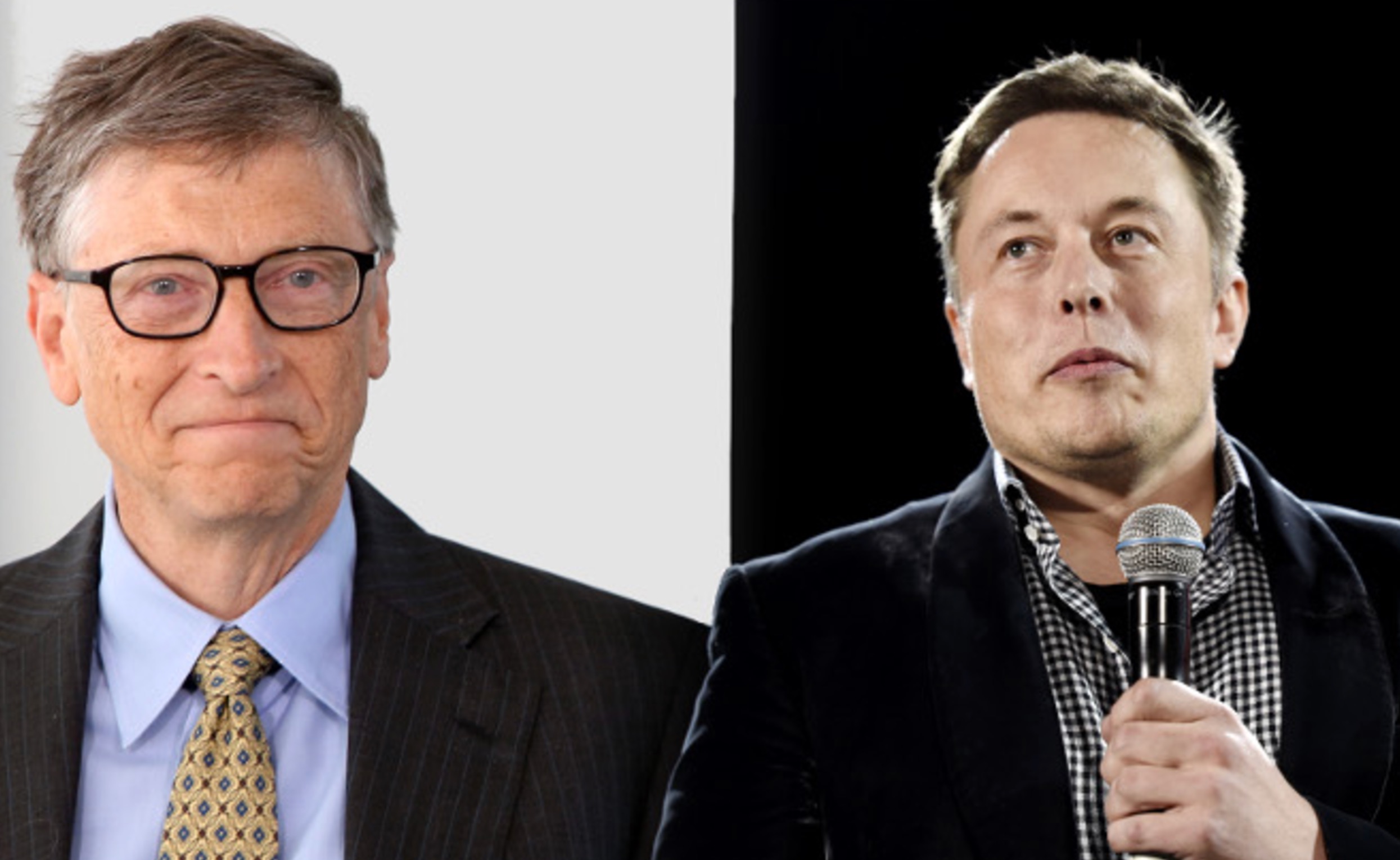
Elon Musk took his latest barb at former Microsoft CEO Bill Gates over his short position against the company, which the two have had some tensions over for a number of years.
Gates admitted to Musk several years ago through a text message that he still held a short position against his sustainable car and energy company. Ironically, Gates had contacted Musk to explore philanthropic opportunities.
Elon Musk explains Bill Gates beef: He ‘placed a massive bet on Tesla dying’
Musk said he could not take the request seriously, especially as Gates was hoping to make money on the downfall of the one company taking EVs seriously.
The Tesla frontman has continued to take shots at Gates over the years from time to time, but the latest comment came as Musk’s net worth swelled to over $600 billion. He became the first person ever to reach that threshold earlier this week, when Tesla shares increased due to Robotaxi testing without any occupants.
Musk refreshed everyone’s memory with the recent post, stating that if Gates still has his short position against Tesla, he would have lost over $10 billion by now:
Bill Gates placed a massive short bet against Tesla of ~1% of our total shares, which might have cost him over $10B by now
— Elon Musk (@elonmusk) December 17, 2025
Just a month ago, in mid-November, Musk issued his final warning to Gates over the short position, speculating whether the former Microsoft frontman had still held the bet against Tesla.
“If Gates hasn’t fully closed out the crazy short position he has held against Tesla for ~8 years, he had better do so soon,” Musk said. This came in response to The Gates Foundation dumping 65 percent of its Microsoft position.
Tesla CEO Elon Musk sends final warning to Bill Gates over short position
Musk’s involvement in the U.S. government also drew criticism from Gates, as he said that the reductions proposed by DOGE against U.S.A.I.D. were “stunning” and could cause “millions of additional deaths of kids.”
“Gates is a huge liar,” Musk responded.
It is not known whether Gates still holds his Tesla short position.
Cybertruck
Tesla Cybertruck gets small change that makes a big difference
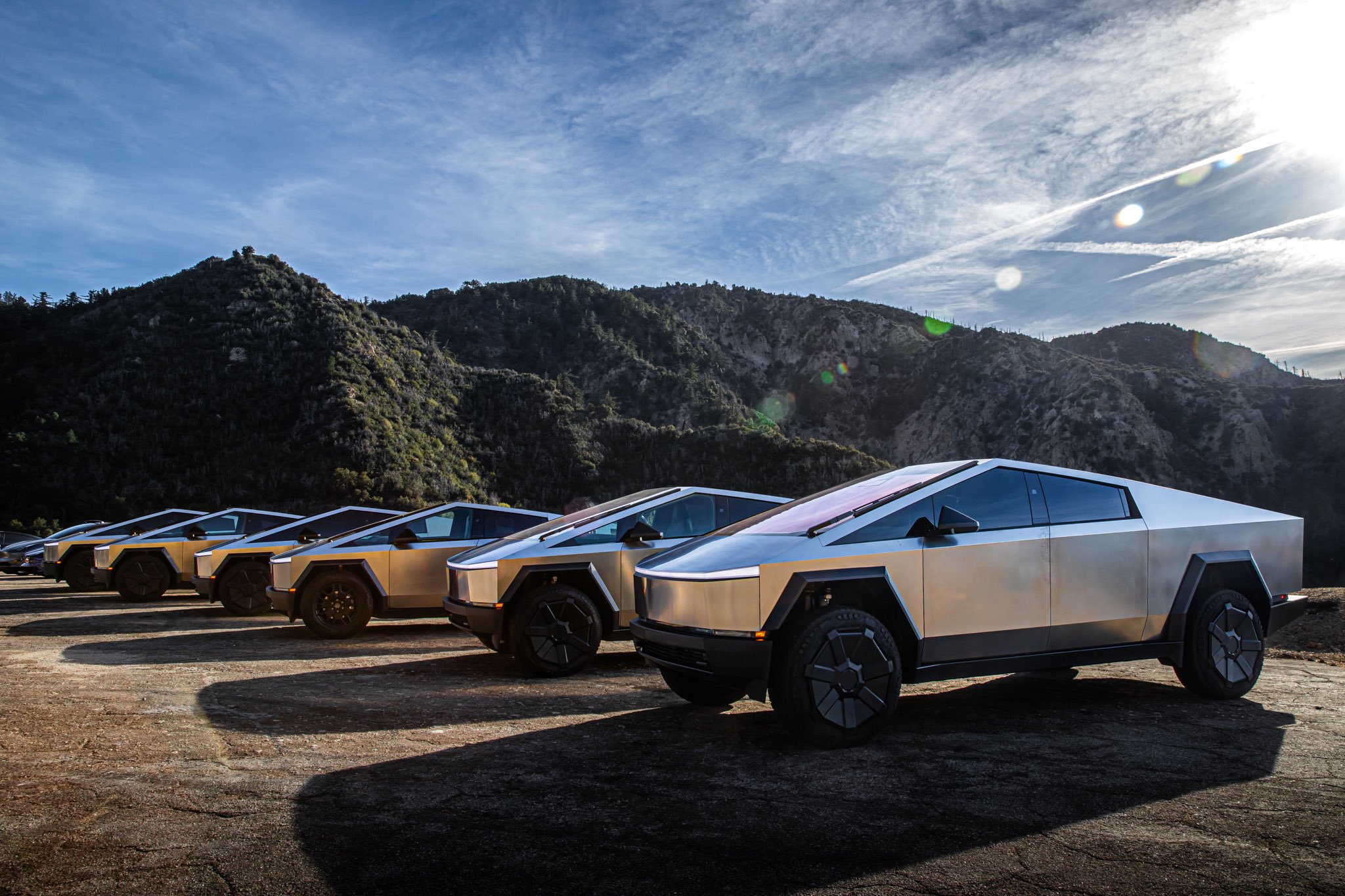
Tesla made a change to the Cybertruck, and nobody noticed. But to be fair, nobody could have, but it was revealed by the program’s lead engineer that it was aimed toward simplifying manufacturing through a minor change in casting.
After the Cybertruck was given a Top Safety Pick+ award by the Insurance Institute for Highway Safety (IIHS), for its reputation as the safest pickup on the market, some wondered what had changed about the vehicle.
Tesla makes changes to its vehicles routinely through Over-the-Air software updates, but aesthetic changes are relatively rare. Vehicles go through refreshes every few years, as the Model 3 and Model Y did earlier this year. However, the Cybertruck is one of the vehicles that has not changed much since its launch in late 2023, but it has gone through some minor changes.
Most recently, Wes Morrill, the Cybertruck program’s Lead Engineer, stated that the company had made a minor change to the casting of the all-electric pickup for manufacturing purposes. This change took place in April:
We made a minor change on the casting for manufacturability in April. Our Internal testing shows no difference in crash result but IIHS only officially tested the latest version
— Wes (@wmorrill3) December 17, 2025
The change is among the most subtle that can be made, but it makes a massive difference in manufacturing efficiency, build quality, and scalability.
Morrill revealed Tesla’s internal testing showed no difference in crash testing results performed by the IIHS.
The 2025 Cybertruck received stellar ratings in each of the required testing scenarios and categories. The Top Safety Pick+ award is only given if it excels in rigorous crash tests. This requires ‘Good’ ratings in updated small and moderate overlap front, side, roof, and head restraints.
Additionally, it must have advanced front crash prevention in both day and night. Most importantly, the vehicle must have a ‘Good’ or ‘Acceptable’ headlights standard on all trims, with the “+ ” specifically demanding the toughest new updated moderate overlap test that checks rear-seat passenger protection alongside driver safety.
